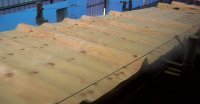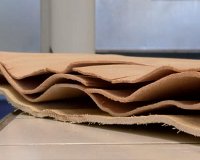Shrinkage in veneers
9 July 2012In a recent practical class on adhesive bond quality, my students remarked on the waviness of the poplar and beech veneers being used. The distortions are due to differential shrinkage during drying. In a situation where a zone shrinks more than an adjacent one there are two outcomes, either the high shrinkage zone splits or the low shrinkage zone buckles, to accommodate the differences in dimensions (see Figure 1).
As a general rule, drying shrinkage is linked to wood density; the higher the density the greater the observed volumetric shrinkage. There are many examples of this between species and within species where trees may be grown in different regions of the world. It also occurs within trees because of density variations, eg knots, early- and late-wood. Plus, there are other influences on shrinkage caused by differences in the ultra-structure of cells in different parts of the tree, ie pith, mature and juvenile wood and the presence of reaction wood.
Reaction wood consists of cells that are specially adapted to resist higher mechanical stresses. Softwoods form compression wood in zones of compressive stress, whereas hardwoods form tension wood in tensile stress zones, eg the tops of branches.
Compression wood consists of tracheids that tend to be rounder and thicker walled. Their circular shape creates more intercellular space, but the main difference, certainly in terms of shrinkage, is that the S2 layer of the cell wall has a much higher microfibril angle.
Tension wood looks rather different under the microscope in that the fibres have an additional layer in the cell wall, called the Glayer, because the extra layer is gelatinous. The G-layer is very cellulose-rich and this explains why the cells are more resistant to tensile stresses. Like compression wood, the longitudinal shrinkage of tension wood is greater than that of normal wood.
Unfortunately for plywood manufacturers, logs are not perfectly round or completely straight. In fact, most are elliptical and slightly bent. Consequently, the lathe will cut through growth rings, creating a band effect. These bands will all shrink slightly differently during drying and will subsequently cause the undulations so often seen in dry veneer. The distortions are easily pressed flat, but they can make veneer handling difficult and cause problems during adhesive application.
On the positive side, the bands of growth rings create 'figure' in the veneer which is often considered decorative.
 Figure 3. Pine veneer as it leaves the lathe, showing early- and late-wood bands caused by
the knife cutting through growth rings
Figure 3. Pine veneer as it leaves the lathe, showing early- and late-wood bands caused by
the knife cutting through growth rings
 Figure 2. A selection of beech and poplar veneers that show the distortion often seen in dry
veneers, especially thick ones
Figure 2. A selection of beech and poplar veneers that show the distortion often seen in dry
veneers, especially thick ones

